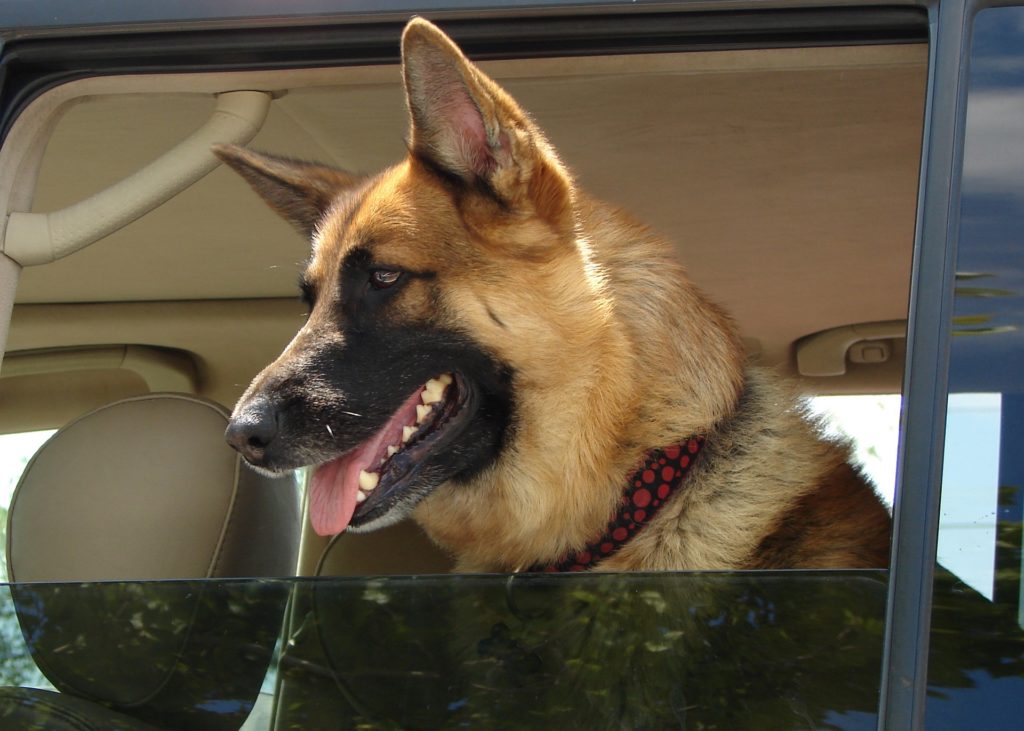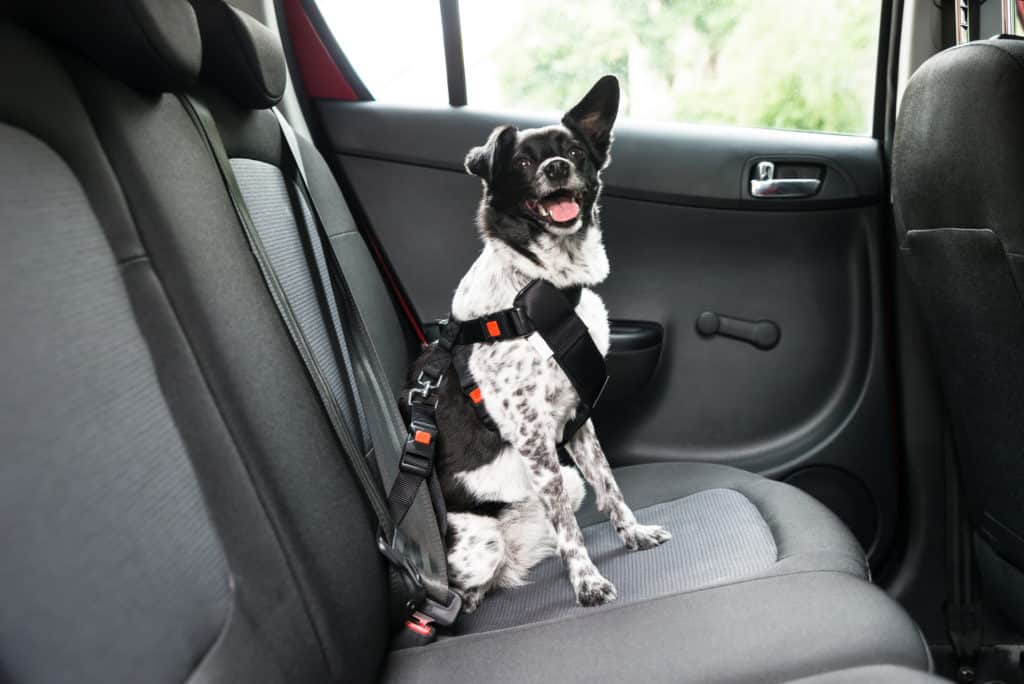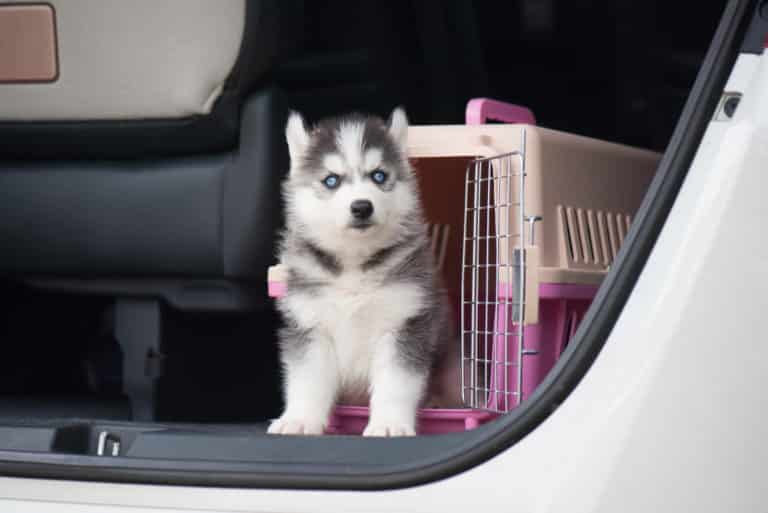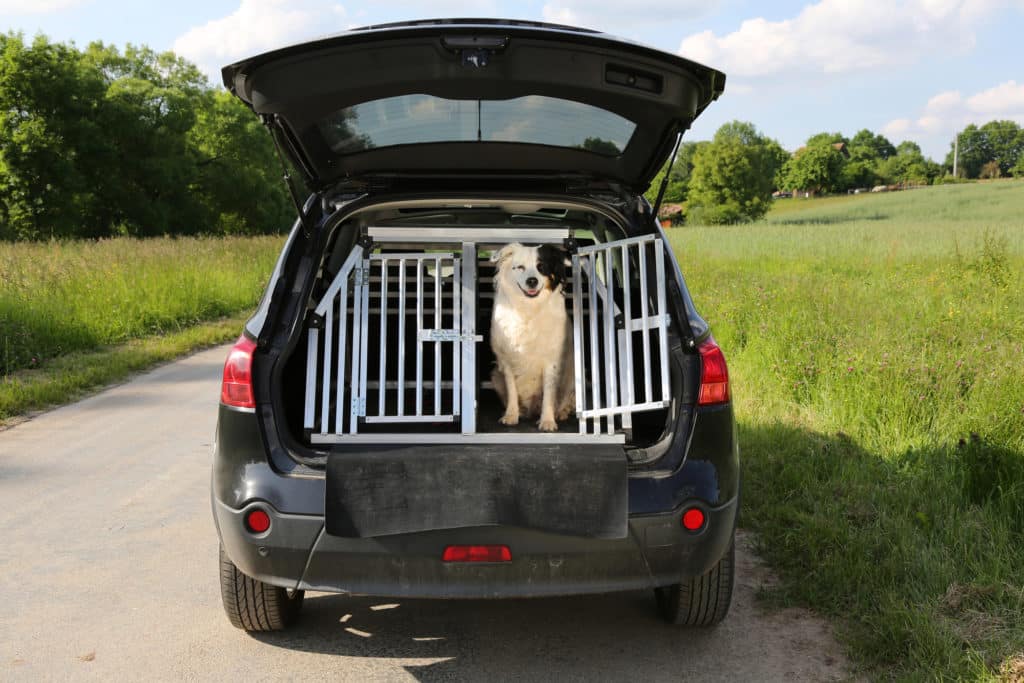Transporting a Dog in the Car? (You Need to Know)
- Claudia Weise
- Updated: 2024-02-09
Want to take your furry friend on vacation, a trip, to the vet, or to visit friends and family far away? Then you can't help but load your four-legged passenger into the car. Without the right precautions and equipment, even a short trip can turn deadly. Read our article to prevent this from happening.

Learn about the legal implications, safety and comfort options for your dog in the car.
Legal
According to road traffic regulations, dogs have the same status as cargo or luggage. Section 23 of the StVO states the following:
"Whoever drives a vehicle is responsible for ensuring that his vision and hearing are not impaired by the occupants, animals, cargo, equipment, or condition of the vehicle. Whoever drives a vehicle shall also see that the vehicle, train, crew, load and occupancy are in accordance with regulations and that the road safety of the vehicle is not impaired by the load or occupancy."
What this means for you is that you need to secure your pet in the car. There are two things to keep in mind:
- In any case, your pet should not disturb you while driving.
- In addition, it must not be thrown forward during emergency braking or in an accident and injure itself or other occupants.
Failure to comply with this regulation will result in a fine of €35. If you also endanger traffic, you will be fined €60 and receive one point in Flensburg.
If you cause an accident because of your unrestrained passenger, your coverage may be voided for gross negligence. However, most dog liability insurance policies cover this.
Even at a low speed of 50 km/h, a medium-sized dog can become a projectile with an impact force of half a ton in the event of an accident. That is why it is absolutely necessary to secure your pet while driving.
Backup Options
There are several methods of securing your dog to ensure that neither you nor your dog will be injured. Which one is best for you depends primarily on the size of your dog. We have put together an overview of the different options for transporting your dog, how to use them, and the advantages and disadvantages of each:
1. Dog Belt

These belts can be attached to the car's seatbelt holders. However, they are usually attached to the Isofix system, which is the car's built-in child seat holder. This is the strongest and safest option.
Never attach the harness to your dog's collar, as this could cause your dog to suffocate during braking and result in injury, including a broken neck. Use the harness to attach your furry friend to a special seat belt. Some harnesses come with their own harness.
A normal chest harness for hiking is generally not designed to absorb the impact forces in the event of a car accident. Special harnesses are available for use in cars and should have the following features
- Crash-tested: A harness should be crash-tested to ensure that it provides adequate protection for the dog in the event of an accident.
- Good padding: The harness should be well padded, especially in the chest area, to distribute pressure and prevent injury in the event of a sudden impact.
- Adjustability: A good harness can be adjusted for different body sizes to ensure an optimal fit.
- Robust material: The materials used should be tear resistant and strong enough to withstand heavy loads.
- Compatibility with vehicle belts: The harness should attach easily and securely to the vehicle seat belt or special dog seat belt.
The quality of the belt determines whether it will hold up in an emergency. Poorly made belts can tear. To avoid this, look for the "ECE" or "DIN" mark.
The seat belt must be appropriate for your dog's size and weight. The length of the belt should be adjusted so that your furry friend cannot reach the backs of the front seats. Seat belts are the most economical way to secure a dog in a car. They are also the easiest to install.
Unfortunately, they are the least safe of the other options. They often leave too much room for the dog to get hurt in a collision or for you to be disturbed while driving.
2. Transport Box

You probably already have a dog carrier at home. It is one of the most versatile and safest ways to transport your pet. You can even use it on an airplane.
Once you get your dog used to it, he will feel very comfortable in it. The crate will become a real shelter.
There are also a few things to keep in mind with this product: Canvas bags do not provide protection in an emergency. You should at least invest in a plastic box. The safest place to store them is in the footwell of the rear seats. There they cannot fly around and break. The strongest crates are made of aluminum.
The size of the kennel must be appropriate for the dog. If it is too big, he may be thrown around and injure himself. If it is too small, it will be too cramped and uncomfortable for your pet.
It should have just enough room to turn around and lie down comfortably. The right size also makes it easier for your pet to rest and not move around in the crate all the time.
The perfect size for your shipping crate is calculated as follows:
The length is the size of your dog plus half the length of his legs. The width should be twice the width of your dog and for the height, add five inches to the head height.
| How should I stow the transport box? | |
|---|---|
| Small box | Place them in the Footwell. |
| Medium size box | Attach them to the Rear seat. |
| Big box | Place them with the long side against the side wall of the Trunk and with the rear side against the rear wall of the rear seats. |
The carrier is one of the safest options for you and also serves as a refuge for your pet. Another benefit is that in the event of an accident, your pet will be immediately secured and will not hinder rescue personnel. Small crates are easy to handle and store.
A disadvantage is that the mounting on the back seat is not strong enough. When in doubt, opt for the trunk. Large dog crates are also difficult to transport due to their heavy weight and unwieldiness. It can also take a long time for your dog to get used to his new home.
3. Separating Grid

To secure your furry passenger in the trunk, you can install a partition between the trunk and the passenger compartment. Never use nets or cheap universal grilles, even if they look cheap and are easy to install.
Nets cannot withstand a strong impact. There is also a risk of entanglement. In most cases, the nets or universal grilles do not seal properly to the vehicle wall. Your furry nose can push forward through the resulting gaps.
Only a sturdy grille that fits your car model will give you the security you need. So choose a model that fits your car perfectly. When installed correctly, it will protect you and your pet.
Make sure that your pet doesn't have too much space when you install it. Otherwise, he or she could be thrown against the grille in an emergency.
4. Dog Seat
A car seat for dogs has now been developed. It attaches like a child seat using the Isofix system and is therefore very safe. However, it is only suitable for small dogs weighing up to nine kilograms.
5. Dog Car Bed (Dogstyler)
Dogstyler dog beds can be secured in the trunk or on the back seat, depending on their size. They use the stable Isofix system, which ensures that they are adequately secured in the back seats.
Your child is secured in the bed with a belt. This is to prevent them from getting out of bed. In this way, they will not obstruct the driver or the emergency services. The belt is not designed to protect them from a collision, that's what the high and padded bed walls are for.
The beds are easy to remove and can also be used at home. They are available in many different sizes, designs and features such as water-repellent material or a removable floor. There are also suitable sizes for all common car models.
Prices range from about $170 for the smallest beds to over $1000 for larger beds with premium features.
If you are willing to spend that much for your pet, you are sure to find what you are looking for. The biggest disadvantage is the rather high price, depending on the bed. Safety and comfort are definitely guaranteed with these beds.
How Do I Get My Dog Used to Driving?
Start getting your furry friend used to the car as early as possible.
At first, let him get in and out of the car without driving, and give him treats now and then. Once you've done this a few times, you can start taking your furry friend for short trips.
Slowly acclimate your dog to driving by starting with short trips and gradually increasing them. This can help reduce anxiety and discomfort.
Always give him a treat before and after the trip and praise him so he looks forward to the ride. Take your pet with you in the car as often as possible so that driving becomes normal for him.
Once you have decided to use a carrier, it is important to get your pet used to it. Do this slowly, with lots of praise and treats, just as you would with the car. It's best to start in a familiar environment, such as your home.
On long trips, take a break every few hours. Let your furry friend run and play. It's best to play extensively with him just before the trip so he'll get tired and sleep during the trip.
Make sure your dog has access to water while driving, especially on hot days. Never leave your dog alone in the car, especially on hot days. The temperature inside the car can rise quickly and cause heatstroke. Protect your pet from direct sunlight. There are sun visors or films that can be attached to the windows.
If your dog is prone to motion sickness, you should stop feeding him or her shortly before the trip. A light meal about 3-4 hours before departure may help prevent nausea. Good ventilation in the car can also help reduce nausea and discomfort. A slightly open window will provide fresh air and may have a calming effect.
Always use a suitable restraint, such as a harness, carrier or special dog seat, to protect your dog during the trip. Make sure the place where your dog sits or lies is comfortable and not too hot or too cold. If necessary, use blankets or pillows for extra comfort.
Remember to Follow These Tips! Never Leave Your Dog Alone in the Car in the Heat!
Even at temperatures of 25 °C, the interior of a car can heat up to 40 °C within half an hour and thus become a death trap. Your pet can only withstand this heat for a few minutes before it dies of circulatory failure.
Open windows or parking in the shade are not enough to prevent this. You also need to make sure your pet does not overheat in the car.
If he is panting heavily, has a red tongue, a stiff neck, and glassy eyes, it is time to cool him down. The best way to do this is with water, a damp cloth, and a cool, shady place.
Overview: How Do I Transport My Dog in the Car?
Where you should transport your dog in the car depends on several factors, including the size of your dog, the type of vehicle, and the safety equipment available. Below are the most common ways to safely transport your dog in the car:
1. Rear Seat
The back seat is often the safest place for medium to large dogs. Your dog can be safely transported with a harness designed specifically for dogs that attaches to the seat belt. The harness should be crash-tested and padded to provide protection in the event of an accident. For small dogs, there are special dog seats that attach to the back seat. These seats raise the dog so it can look out the window and usually have an internal anchorage for the dog harness.
2. Trunk of Station Wagons and Suvs
A well-secured carrier or cage in the trunk can provide a great deal of safety and comfort, especially for large dogs. The crate should be sturdy and securely anchored in the trunk to prevent it from moving in the event of an accident. If you are using an open trunk without a crate, we recommend a grille or net to keep your dog out of the passenger compartment. This is a good solution for very large dogs or when transporting multiple dogs.
3. In the Footwell Behind the Front Seats
Carrying a small dog in the footwell behind the front seat can be safe under certain conditions, especially for short trips or when there is no other option. This area provides protection from direct sunlight and can prevent your dog from being thrown around the vehicle in the event of a sudden stop. However, this area should only be used if there is enough room for your dog to lie comfortably without being crushed. Make sure your dog cannot crawl under the seats or get caught in any equipment. We recommend a special harness or carrier that can be securely fastened in the footwell.
Conclusion
The type of dog restraint you choose for your car depends largely on the space available in your car, the size of your dog, and your financial situation. The important thing is that you secure it. How you do that is up to you.
Now you have an idea of the different transportation options for your pet. You also know how to get him used to driving and what to look out for to keep you and your best friend safe.

I'm editor-in-chief at Hundeo and when it comes to dogs, my heart beats faster. My goal is to publish the best dog guides on the web. There is a lot of passion in every article and I welcome any feedback to constantly improve our content.
Share Now:

